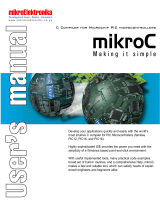
3.3 Keyboard Wedge Interface ...................................................................................................................60
3.3.1 Definition of the WedgeSetting Array....................................................................................60
3.3.2 KBD / Terminal Type.............................................................................................................61
3.3.3 Capital Lock Auto-Detection..................................................................................................62
3.3.4 Capital Lock Status Setting ....................................................................................................62
3.3.5 Alphabets Case .......................................................................................................................62
3.3.6 Digits Position ........................................................................................................................63
3.3.7 Shift / Capital Lock Keyboard................................................................................................63
3.3.8 Digit Transmission .................................................................................................................63
3.3.9 Inter-Character Delay .............................................................................................................64
3.3.10 Composition of Output String ..............................................................................................64
3.4 Buzzer...................................................................................................................................................67
3.4.1 Beeper Sequence.....................................................................................................................67
3.4.2 Beep Frequency ......................................................................................................................67
3.4.3 Beep Duration.........................................................................................................................68
3.5 Real-time Clock ....................................................................................................................................70
3.5.1 Calendar..................................................................................................................................70
3.5.2 Alarm......................................................................................................................................72
3.6 LED ......................................................................................................................................................73
3.7 Keypad..................................................................................................................................................74
3.7.1 General ...................................................................................................................................74
3.7.2 ALPHA Key ...........................................................................................................................77
3.7.3 FN Key ...................................................................................................................................80
3.8 LCD ......................................................................................................................................................80
3.8.1 Properties................................................................................................................................81
3.8.2 Cursor .....................................................................................................................................84
3.8.3 Display....................................................................................................................................87
3.8.4 Clear .......................................................................................................................................92
3.8.5 Image ......................................................................................................................................94
3.9 Fonts .....................................................................................................................................................96
3.9.1 Font Size.................................................................................................................................96
3.9.2 Display Capability ..................................................................................................................96
3.9.3 Multi-Language Font..............................................................................................................97
3.9.4 Special Fonts ..........................................................................................................................97
3.9.5 Font Files..............................................................................................................................100
3.10 Battery...............................................................................................................................................101
3.11 Communication Ports .......................................................................................................................103
3.11.1 Port Mapping ......................................................................................................................103
3.11.2 Receive & Transmit Buffers...............................................................................................103
3.11.3 RS-232, Serial IR & IrDA Communications ......................................................................109
3.11.4 PPP via IR/RS-232 .............................................................................................................112
3.12 Wireless Communications ................................................................................................................114
3.13.1 Wireless Models .................................................................................................................115
3.13.2 Network Configuration.......................................................................................................118
3.13.3 Initialization & Termination ...............................................................................................133
3.13.4 Network Status ...................................................................................................................135
3.13.5 WLAN (802.11b)................................................................................................................140
3.13.6 Bluetooth ............................................................................................................................174
3.13 Wireless Practice...............................................................................................................................180
3.13.1 WLAN (802.11b) - Practice ...............................................................................................180
3.13.2 Bluetooth - Practice ............................................................................................................182
3.14 File Manipulation..............................................................................................................................186
3.14.1 File System .........................................................................................................................186
3.14.2 Directory.............................................................................................................................186
3.14.3 File Name ...........................................................................................................................186




















